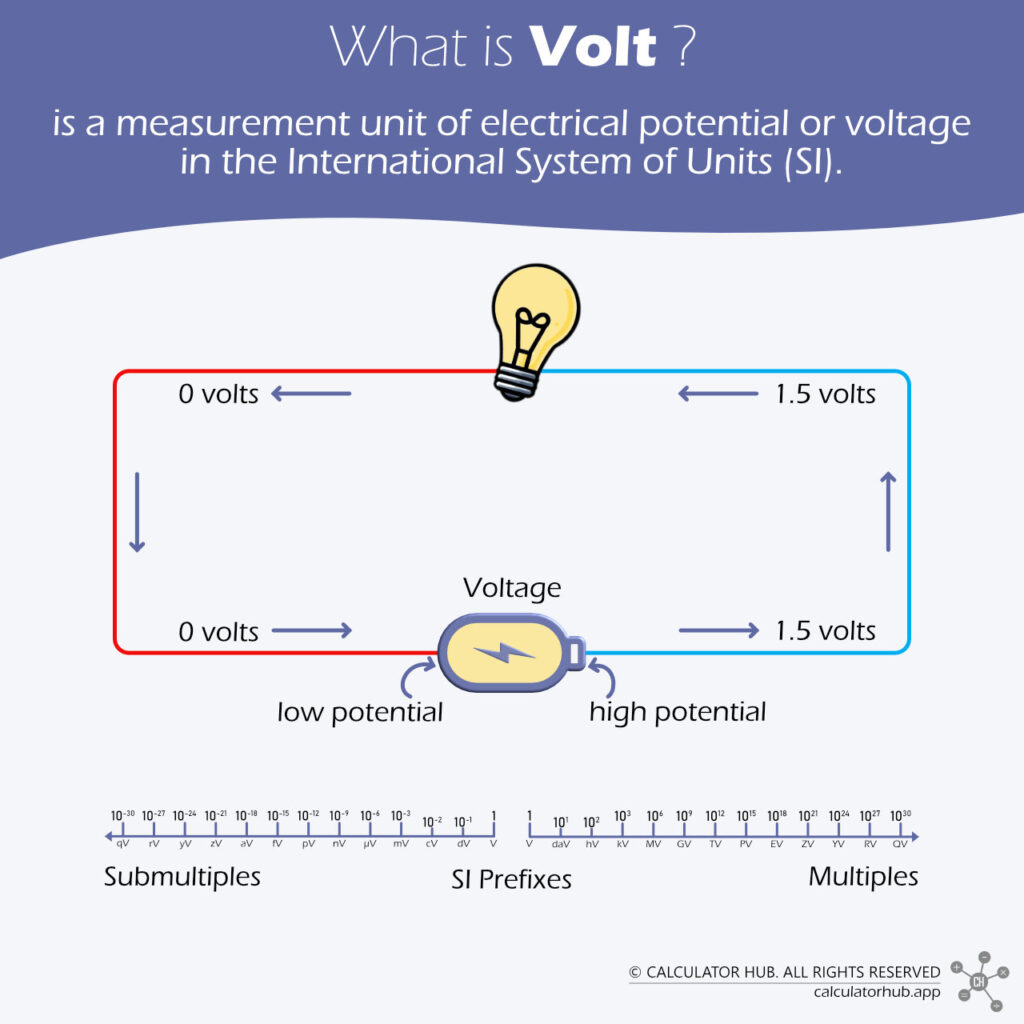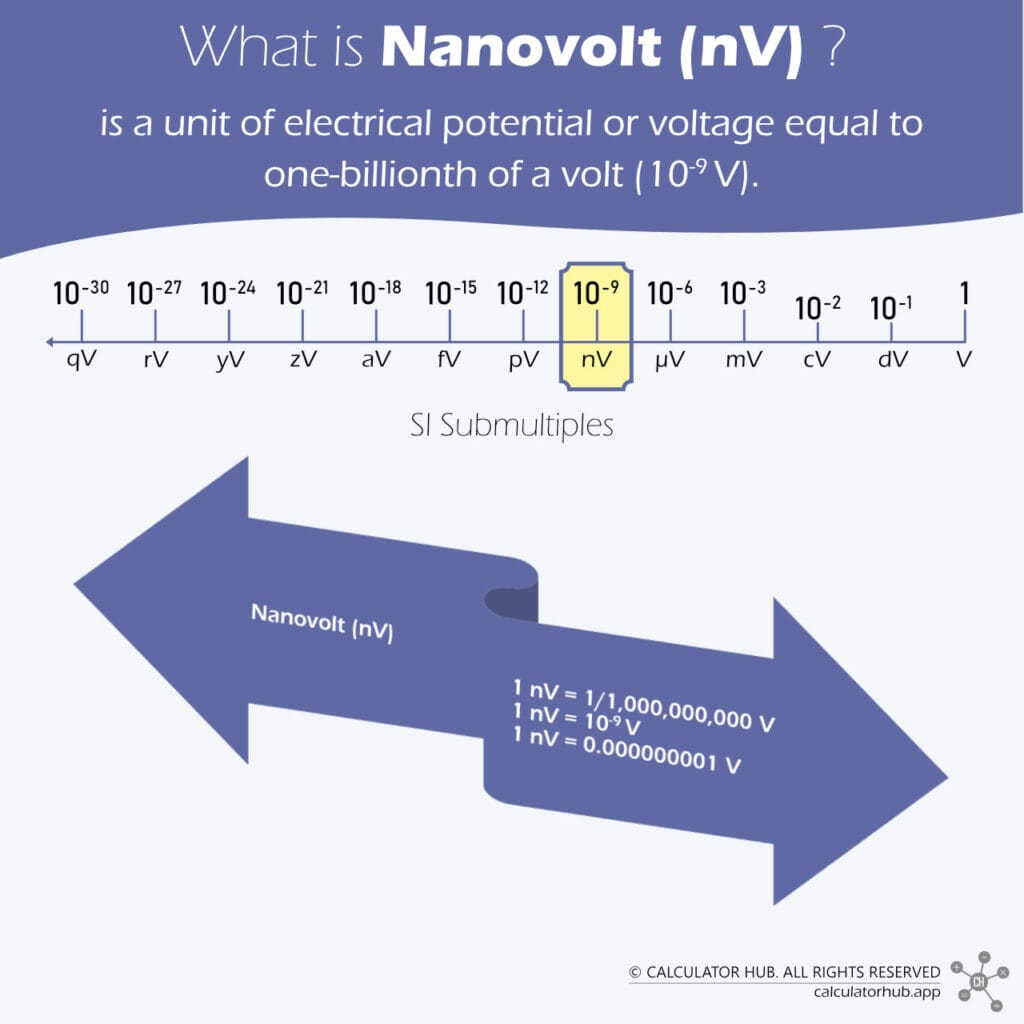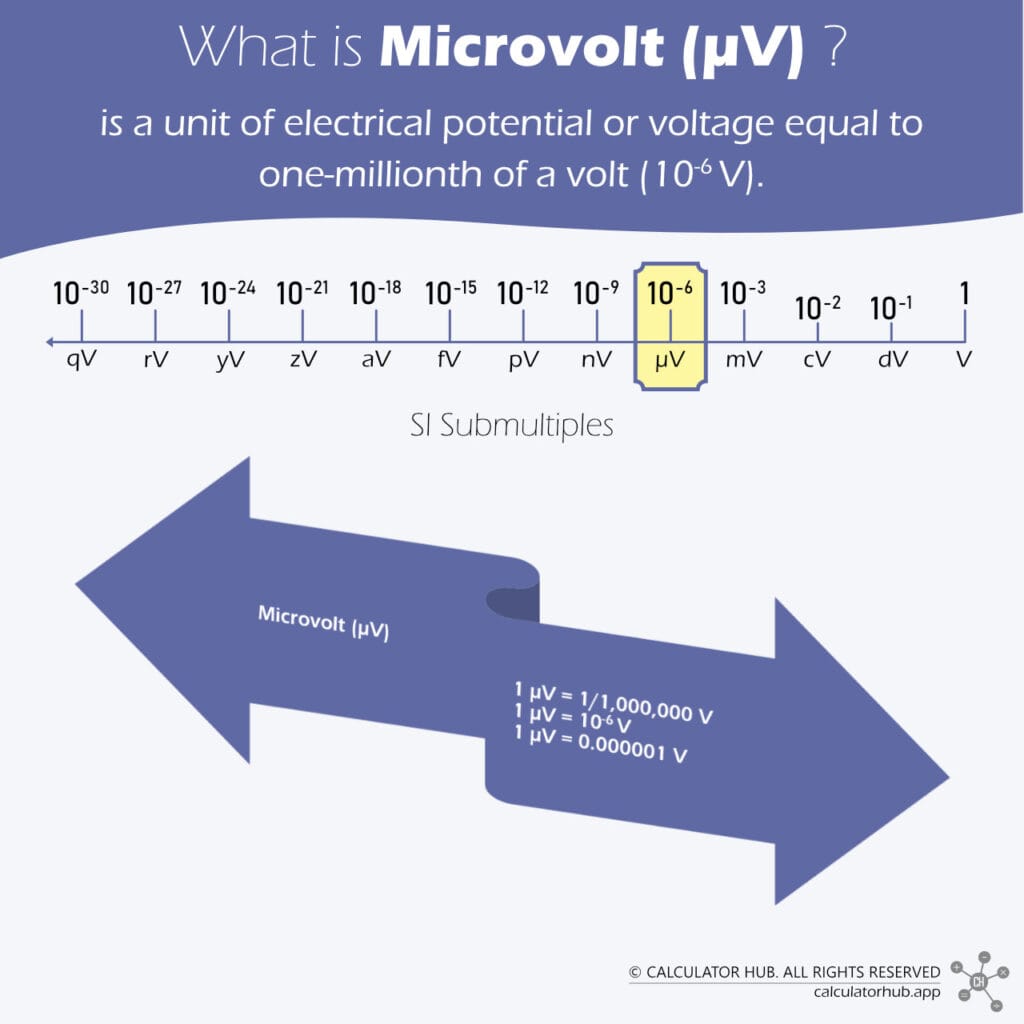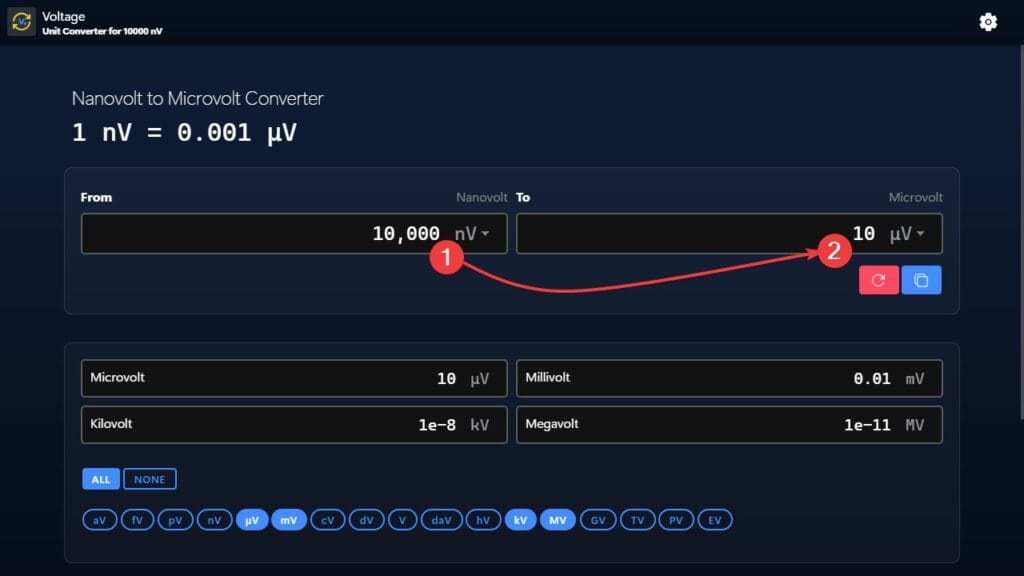This article will show how to convert voltage measurement units from nanovolts (nV) to microvolts (µV). We will cover essential definitions, provide examples, share relevant formulas, and present tables, along with answers to common questions.
Definitions of Volt, Nanovolt, and Microvolt
Let’s get started by understanding the key definitions of Volt (V), Nanovolt (nV), and Microvolt (µV). Understanding these terms will allow you to perform conversions confidently.
What is Volt (V)?
A volt (V) is the SI (International System of Units) unit of electric potential and voltage. It measures the difference in electric energy between two points in a circuit. One volt means one ampere of current uses one watt of power.[1]
According to SI prefixes[2], which are based on powers of 10, a volt (1 V) is equivalent to one billion nanovolts, or 109 nV, or 1,000,000,000 nV.

What is Nanovolt (nV)?
A nanovolt (nV) is a unit of electrical potential equal to one-billionth (1/1,000,000,000) of a volt (10-9 V). It is primarily used in high-precision electrical measurements, such as scientific instrumentation, quantum electronics, and sensitive signal detection, where extremely small voltage variations must be accurately captured and analyzed.

Its ultra-small scale makes it essential for applications requiring minimal interference and precise voltage control.
What is Microvolt (µV)?
A microvolt (µV) is a unit of electrical potential equal to one-millionth (1/1,000,000) of a volt (0.000001 V). It is commonly used in applications requiring high-precision voltage measurements, such as biomedical sensors (e.g., EEG and ECG devices), seismic monitoring, and radio signal detection, where extremely small electrical signals must be accurately captured and analyzed.

Its fine resolution makes it essential for systems sensitive to even the slightest voltage variations.
nV to µV formula
Let’s take a closer look at the conversion formula so you can carry out these conversions independently, whether using a calculator or doing it manually with pencil and paper.
The nano- prefix in the International System of Units (SI) represents a multiplier of 10-9 (0.000000001) while the micro- represents a multiplier of 10-6 (0.000001).
So, to convert from nanovolts to microvolts, divide the number of nanovolts (V(nV)) by 1,000.
V(µV) = V(nV) ÷ 103 = V(nV) ÷ 1,000
Or remember the nV-to-µV conversion factor: 1 nV = 10-3 = 0.001 µV
nV to µV conversion table
The conversion table below provides a handy reference for converting voltage measurement units from nanovolts (nV) to microvolts (µV). It covers a range from 0.1 nV to 1,000 nV, allowing for easy and quick conversions between both units of measurement.
| Nanovolts (nV) | Microvolts (µV) |
|---|---|
| 0.1 nV | 0.0001 µV |
| 0.5 nV | 0.0005 µV |
| 1 nV | 0.001 µV |
| 2 nV | 0.002 µV |
| 4 nV | 0.004 µV |
| 5 nV | 0.005 µV |
| 10 nV | 0.01 µV |
| 20 nV | 0.02 µV |
| 30 nV | 0.03 µV |
| 40 nV | 0.04 µV |
| 50 nV | 0.05 µV |
| 60 nV | 0.06 µV |
| 70 nV | 0.07 µV |
| 80 nV | 0.08 µV |
| 90 nV | 0.09 µV |
| 100 nV | 0.1 µV |
| 200 nV | 0.2 µV |
| 500 nV | 0.5 µV |
| 800 nV | 0.8 µV |
| 1,000 nV | 1 µV |
Examples
Now, let's look at an example that illustrates the calculations required to convert from nanovolts to microvolts (nV to µV).
Example: Photodetector Output in Optoelectronic Sensors
In optoelectronic applications, photodetectors measure extremely weak voltage signals induced by low-light conditions, where exact detection is paramount for system performance. By converting signals from nanovolts to microvolts, the output becomes standardized and more manageable, aiding in the precise comparison and calibration of sensor readings.
For example, a photodetector outputs a voltage of 10,000 nV. Your task is to convert this measurement to microvolts for better analysis and integration with other sensor data.
Solution
Since 1 microvolts (µV) = 1,000 nanovolts (nV), we can convert 10,000 nV to microvolts by using the following formula:
Therefore, the 10,000 nV output voltage of the photodetector is equivalent to 10 µV.
To solve the problem with our calculator, follow the steps below:
- Enter the value in nanovolts – For this example, enter
10,000into theFrombox. - View the result – The converter instantly calculates and displays the equivalent value in microvolts:
10 µV.

FAQs
Is 1 nanovolt or 1 microvolt larger?
A microvolt (µV) is a thousand times bigger than a nanovolt (nV). Here are the relationships between the units:
1 µV = 103 = 1,000 nV1 nV = 10-3 = 1 ÷ 1,000 = 0.001 µV
How to convert from nanovolts to microvolts?
To convert voltage from nanovolts (nV) to microvolts (µV), follow these simple steps:
- Write down the voltage value in
nanovolts (nV). - Multiply it by the value of the
nV-to-µVconversion factor:10-3or0.001. - The result of the multiplication is the value of the voltage in
microvolts (µV).
Why do I need to convert from nanovolts to microvolts?
Converting nanovolts (nV) to microvolts (µV) is essential for making extremely small voltage measurements more manageable and easier to interpret. While nanovolt readings capture every detail, expressing them in microvolts (1 µV = 1,000 nV) simplifies calculations, improves clarity, and aligns measurement data with standard calibration and high-precision equipment.
This conversion minimizes computational errors and greatly enhances the analysis and monitoring of minute voltage fluctuations in high-precision applications.
You now know how to convert voltage from nanovolts (nV) to microvolts (µV). You can quickly use our calculator to convert between the voltage measurement units to save time for future calculations.

